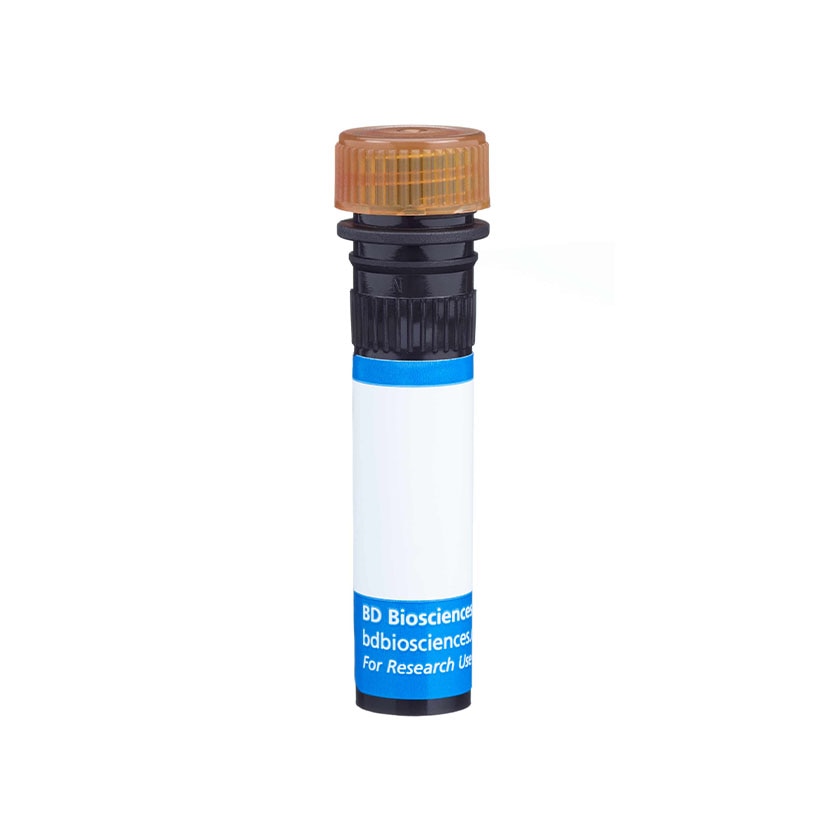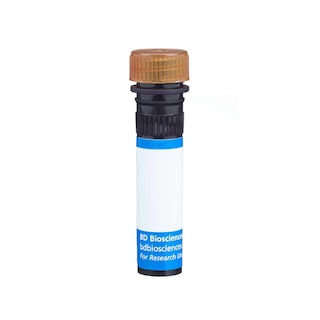Old Browser
Looks like you're visiting us from {countryName}.
Would you like to stay on the current country site or be switched to your country?




Analysis of CD117 on mouse bone marrow. Bone marrow cells from BALB/c mice were stained either with a PerCP-Cy™5.5 Rat IgG2b, κ isotype control (left panel) or with the PerCP-Cy™5.5 Rat Anti-Mouse CD117 antibody (right panel). Dot plots were derived from gated events based on light scattering characteristics for CD45R- bone marrow cells. Flow cytometry was performed on a BD™ LSR II flow cytometry system.


BD Pharmingen™ PerCP-Cy™5.5 Rat Anti-Mouse CD117

监管状态图例
未经BD明确书面授权,严禁使用未经许可的任何商品。
准备和存储
商品通知
- Since applications vary, each investigator should titrate the reagent to obtain optimal results.
- An isotype control should be used at the same concentration as the antibody of interest.
- Please observe the following precautions: Absorption of visible light can significantly alter the energy transfer occurring in any tandem fluorochrome conjugate; therefore, we recommend that special precautions be taken (such as wrapping vials, tubes, or racks in aluminum foil) to prevent exposure of conjugated reagents, including cells stained with those reagents, to room illumination.
- This PerCP-conjugated product is sold under license to the following patent: US Patent No. 4,876,190.
- Cy is a trademark of Amersham Biosciences Limited. This conjugated product is sold under license to the following patents: US Patent Nos. 5,486,616; 5,569,587; 5,569,766; 5,627,027.
- This product is subject to proprietary rights of Amersham Biosciences Corp. and Carnegie Mellon University and made and sold under license from Amersham Biosciences Corp. This product is licensed for sale only for research. It is not licensed for any other use. If you require a commercial license to use this product and do not have one return this material, unopened to BD Biosciences, 10975 Torreyana Rd, San Diego, CA 92121 and any money paid for the material will be refunded.
- PerCP-Cy5.5 is optimized for use with a single argon ion laser emitting 488-nm light. Because of the broad absorption spectrum of the tandem fluorochrome, extra care must be taken when using dual-laser cytometers, which may directly excite both PerCP and Cy5.5™. We recommend the use of cross-beam compensation during data acquisition or software compensation during data analysis.
- PerCP-Cy5.5–labelled antibodies can be used with FITC- and R-PE–labelled reagents in single-laser flow cytometers with no significant spectral overlap of PerCP-Cy5.5, FITC, and R-PE fluorescence.
- Caution: Sodium azide yields highly toxic hydrazoic acid under acidic conditions. Dilute azide compounds in running water before discarding to avoid accumulation of potentially explosive deposits in plumbing.
- For fluorochrome spectra and suitable instrument settings, please refer to our Multicolor Flow Cytometry web page at www.bdbiosciences.com/colors.
- Please refer to www.bdbiosciences.com/us/s/resources for technical protocols.
The 2B8 monoclonal antibody specifically binds to CD117 (c-Kit), a transmembrane tyrosine-kinase receptor that is encoded by the Kit gene (formerly dominant white spotting, W). The c-Kit ligand (also known as steel factor, stem cell factor, and mast cell growth factor) encoded by the Kit1 gene (formerly steel, SI), is a co-mitogen for hematopoietic stem cells, myeloerythroid progenitors and a mast-cell differentiation factor. The KitW and Kit1SI mutant alleles have similar pleiotropic effects on the development of melanocytes, germ cells, and the hematopoietic system. In the adult bone marrow, CD117 is expressed on hematopoietic progenitor cells, including CD90 (Thy-1) low, TER-119-, CD45R/B220-, CD11b (Mac-1)-, Ly-6G (Gr-1)-, CD4-, CD8-, and Sca-1 (Ly-6A/E)+ multipotent hemotopoietic stem cells, progenitors committed to myeliod and/or erythroid lineages, and precursors of B and T lymphocytes. This widespread expression of CD117 in hematopoietic precursors is consistent with the participation of c-Kit and its ligand in the regulation of several hematopoietic lineages. Intrathymic expression of c-Kit and c-Kit ligand suggest that CD117 is also involved in the regulation of some events during the development of T lymphocytes. CD117 is also expressed by mast cells and by dendritic cells found in the periarteriolar lymphocytoc sheaths (T-cell areas) of splenic white pulp. The mAb 2B8 reportedly does not block the action of c-Kit. This clone 2B8 had been reported to cross-react with rat.

研发参考 (27)
-
Anderson DM, Lyman SD, Baird A, et al. Molecular cloning of mast cell growth factor, a hematopoietin that is active in both membrane bound and soluble forms. Cell. 1990; 63(1):235-243. (Biology). 查看参考
-
Austen KF, Boyce JA. Mast cell lineage development and phenotypic regulation. Leuk Res. 2001; 25(7):511-518. (Biology). 查看参考
-
Domen J, Weissman IL. Hematopoietic stem cells need two signals to prevent apoptosis; BCL-2 can provide one of these, Kitl/c-Kit signaling the other. J Exp Med. 2000; 192(12):1707-1718. (Biology). 查看参考
-
Godfrey DI, Kennedy J, Mombaerts P, Tonegawa S, Zlotnik A. Onset of TCR-β gene rearrangement and role of TCR-β expression during CD3-CD4-CD8- thymocyte differentiation. J Immunol. 1994; 152(10):4783-4792. (Biology). 查看参考
-
Godfrey DI, Zlotnik A, Suda T. Phenotypic and functional characterization of c-kit expression during intrathymic T cell development. J Immunol. 1992; 149(7):2281-2285. (Biology). 查看参考
-
Godfrey DI, Zlotnik A. Control points in early T-cell development. Immunol Today. 1993; 14(11):547-553. (Biology). 查看参考
-
Huang E, Nocka K, Beier DR, et al. The hematopoietic growth factor KL is encoded by the Sl locus and is the ligand of the c-kit receptor, the gene product of the W locus. Cell. 1990; 63(1):225-233. (Biology). 查看参考
-
Ikuta K, Weissman IL. Evidence that hematopoietic stem cells express mouse c-kit but do not depend on steel factor for their generation. Proc Natl Acad Sci U S A. 1992; 89(4):1502-1506. (Immunogen: Flow cytometry, Immunoprecipitation). 查看参考
-
Katayama N, Shih JP, Nishikawa S, Kina T, Clark SC, Ogawa M. Stage-specific expression of c-kit protein by murine hematopoietic progenitors. Blood. 1993; 82(8):2353-2360. (Biology). 查看参考
-
Kondo M, Weissman IL, Akashi K. Identification of clonogenic common lymphoid progenitors in mouse bone marrow. Cell. 1997; 91(5):661-672. (Biology). 查看参考
-
Lian Z, Toki J, Yu C, et al. Intrathymically injected hemopoietic stem cells can differentiate into all lineage cells in the thymus: differences between c-kit+ cells and c-kit < low cells. Stem Cells. 1997; 15(6):430-436. (Biology). 查看参考
-
Matsuzaki Y, Gyotoku J, Ogawa M, et al. Characterization of c-kit positive intrathymic stem cells that are restricted to lymphoid differentiation. J Exp Med. 1993; 178(4):1283-1292. (Biology). 查看参考
-
Mirmonsef P, Shelburne CP, Fitzhugh Yeatman C 2nd, Chong HJ, Ryan JJ. Inhibition of Kit expression by IL-4 and IL-10 in murine mast cells: role of STAT6 and phosphatidylinositol 3'-kinase. J Immunol. 1999; 163(5):2530-2539. (Biology). 查看参考
-
Moore T, Huang S, Terstappen LW, Bennett M, Kumar V. Expression of CD43 on murine and human pluripotent hematopoietic stem cells. J Immunol. 1994; 153(11):4978-4987. (Biology). 查看参考
-
Nishikawa S, Kusakabe M, Yoshinaga K, et al. In utero manipulation of coat color formation by a monoclonal anti-c-kit antibody: two distinct waves of c-kit-dependency during melanocyte development. EMBO J. 1991; 10(8):2111-2118. (Biology). 查看参考
-
Ogawa M, Matsuzaki Y, Nishikawa S, et al. Expression and function of c-kit in hemopoietic progenitor cells. J Exp Med. 1991; 174(1):63-71. (Biology). 查看参考
-
Ogawa M, Nishikawa S, Yoshinaga K, et al. Expression and function of c-Kit in fetal hemopoietic progenitor cells: transition from the early c-Kit-independent to the late c-Kit-dependent wave of hemopoiesis in the murine embryo. Development. 1993; 117(3):1089-1098. (Biology). 查看参考
-
Orlic D, Fischer R, Nishikawa S, Nienhuis AW, Bodine D. Purification and characterization of heterogeneous pluripotent hematopoietic stem cell populations expressing high levels of c-kit receptor. Blood. 1993; 82(3):762-770. (Biology). 查看参考
-
Pulendran B, Lingappa J, Kennedy MK, et al. Developmental pathways of dendritic cells in vivo: distinct function, phenotype, and localization of dendritic cell subsets in FLT3 ligand-treated mice. J Immunol. 1997; 159(5):2222-2231. (Biology). 查看参考
-
Rico-Vargas SA, Weiskopf B, Nishikawa S, Osmond DG. c-kit expression by B cell precursors in mouse bone marrow. Stimulation of B cell genesis by in vivo treatment with anti-c-kit antibody. J Immunol. 1994; 152(6):2845-2852. (Biology). 查看参考
-
Rodewald HR, Dessing M, Dvorak AM, Galli SJ. Identification of a committed precursor for the mast cell lineage. Science. 1996; 271(5250):818-822. (Biology). 查看参考
-
Rodewald HR, Kretzschmar K, Swat W, Takeda S. Intrathymically expressed c-kit ligand (stem cell factor) is a major factor driving expansion of very immature thymocytes in vivo. Immunity. 1995; 3(3):313-319. (Biology). 查看参考
-
Rodewald HR, Kretzschmar K, Takeda S, Hohl C, Dessing M. Identification of pro-thymocytes in murine fetal blood: T lineage commitment can precede thymus colonization. EMBO J. 1994; 13(18):4229-4240. (Biology). 查看参考
-
Valent P. The riddle of the mast cell: kit(CD117)-ligand as the missing link?. Immunol Today. 1994; 15(3):111-114. (Biology). 查看参考
-
Yamamoto Y, Yasumizu R, Amou Y, et al. Characterization of peripheral blood stem cells in mice. Blood. 1996; 88(2):445-454. (Biology). 查看参考
-
Zsebo KM, Williams DA, Geissler EN, et al. Stem cell factor is encoded at the Sl locus of the mouse and is the ligand for the c-kit tyrosine kinase receptor. Cell. 1990; 63(1):213-224. (Biology). 查看参考
-
Zsebo KM, Wypych J, McNiece IK, et al. Identification, purification, and biological characterization of hematopoietic stem cell factor from buffalo rat liver--conditioned medium. Cell. 1990; 63(1):195-201. (Biology). 查看参考
Please refer to Support Documents for Quality Certificates
Global - Refer to manufacturer's instructions for use and related User Manuals and Technical data sheets before using this products as described
Comparisons, where applicable, are made against older BD Technology, manual methods or are general performance claims. Comparisons are not made against non-BD technologies, unless otherwise noted.
For Research Use Only. Not for use in diagnostic or therapeutic procedures.
Report a Site Issue
This form is intended to help us improve our website experience. For other support, please visit our Contact Us page.
